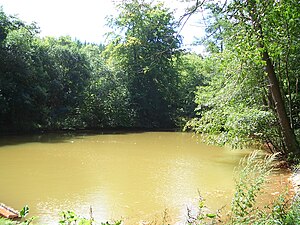Mensing pond
| Mensing pond | |||||||||
|---|---|---|---|---|---|---|---|---|---|
| Mensing pond from the dam | |||||||||
|
|||||||||
|
|
|||||||||
| Coordinates | 51 ° 43 '8 " N , 11 ° 7' 38" E | ||||||||
| Data on the structure | |||||||||
| Construction time: | 17th century renovation in 2006 | ||||||||
| Crown length: | 23 m | ||||||||
| Crown width: | 3.5 m | ||||||||
| Data on the reservoir | |||||||||
| Water surface | 0.19 ha | ||||||||
The Mensingteich is an old reservoir near Gernrode in the Harz in Saxony-Anhalt . The Steinbach is dammed in it; the receiving waters are the Bode and the Saale . The new pond , 3.5 km away, can be reached from the pond via the Hagentalsweg . The Mensing pond is registered as an artificial pond in the local monument register.
history
The pond was probably created in the 17th century as a fish and mill pond for the water mill in Hagental. The mill served as a grain mill. Other details indicate a sawmill . The original name of the pond was Hagentalteich. The pond was given its current name after the miller from Gatersleben, Friedrich Christian Mensing, who bought the water mill in 1857. The mill gave up its operation in 1870, according to other information in 1900.
Since 1970 the Steinbach and the Mensingteich supplied by it have lost a lot of quality with the beginning of the mining for fluorspar in the mine Hohe Warte above the pond. The pit water flowing out of the pit has a low pH value, low oxygen content and contains iron. On the way to the pond, the water is enriched with oxygen through natural processes and the iron it contains oxidizes to orange-red iron oxyhydrate. This iron oxyhydrate settles on the pond floor and the brook brine and thus prevents the settlement of plants and small organisms. In 1985 the tunnel was closed, but uncleaned pit water flowed from the pit into the Hagenbach for a long time.
In 2006, the refurbishment of the Mensing pond began. First, the pond was completely emptied and the pond bottom contaminated with iron sludge was disposed of. The dam, for the renovation of which disused railway sleepers had been used, was also renewed. A new drain was also created. The pond was divided into an upper and a lower section with the help of a small dam. The two parts are connected by means of an overflow. This is done to keep the water clean so that the sludge transported through the stream settles in the upper part of the pond and the water regains its quality.
See also: List of waters in Saxony-Anhalt
literature
- Rosemarie and Gerhard Kellermann, Chronicle of the City of Gernrode , Gernroder Kulturverein Andreas Popperodt eV 2013, p. 179 f.
- State Office for the Preservation of Monuments of Saxony-Anhalt (Ed.): List of monuments in Saxony-Anhalt. Volume 7.2: Falko Grubitzsch, with the participation of Winfried Korf and Theo Gosselke: Quedlinburg district. Halle 2007, ISBN 978-3-86568-072-3 , p. 120.
Individual evidence
- ↑ a b c Rosemarie and Gerhard Kellermann, Chronicle of the City of Gernrode , Gernroder Kulturverein Andreas Popperodt eV 2013, p. 167
- ↑ State Office for the Preservation of Monuments in Saxony-Anhalt (ed.): List of monuments in Saxony-Anhalt. Volume 7.2: Falko Grubitzsch, with the participation of Winfried Korf and Theo Gosselke: Quedlinburg district. Halle 2007, ISBN 978-3-86568-072-3 , p. 120
- ↑ Rosemarie and Gerhard Kellermann, Chronicle of the City of Gernrode , Gernroder Kulturverein Andreas Popperodt eV 2013, p. 179

